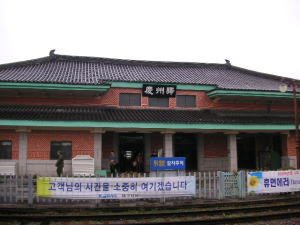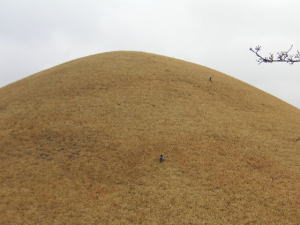 |
A Royal tomb Tumuli
Can you see two birds on the grass?
Magpies!
This white-and-black crow immigrated from Korea to Saga Prefecture of Kyushu,
where our Karatsu City is, some 400 years ago. They flourished, and even
in Yoyokaku's garden, we can see them.
If you see them in the morning, it means that you will win today!
|
The Tumuli Park Belt
This belt consists of three groups of royal tombs. Most of the tumuli are
shaped like domes or mounds of earth. However, some are shaped like gourds or
half-moons. Excavated tombs reveal wooden coffins covered with gravel and rich
grave goods of gold, glass, and quality ceramics. A famous example of a tomb in
this park is the Heavenly Horse Tomb which contained a mural
painting on birch bark saddle flap of a winged horse.
|
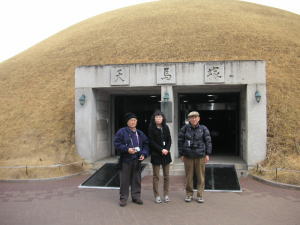
at Heavenly Horse Tomb,
Mr. Noguchi, Korean guide, Mr. Kaneko
|

Up to the Seokguram Grotto along the snow path |
The Seokguram Grotto is a hermitage and part of the Bulguksa temple complex. It lies four
kilometers east of the temple on Mt. Tohamsan, in Gyeongju, South Korea. The grotto overlooks the Sea of Japan (East Sea) and
rests 750 meters above sea level. In 1962, it was designated the 24th national treasure of Korea. In
1995, Seokguram was added to the UNESCO
World Heritage List together with the
Bulguksa Temple. It exemplifies some of the best Buddhist sculptures in the
world. [1]
It is said to have been built by Gim Daeseong and originally called
Seokbulsa (석불사, Stone Buddha Temple). Construction began in 742
when Gim Daeseong resigned his position in the king's court or in 751, the 10th
year of the reign of King Gyeongdeok of Silla. This time period was
the cultural peak of Unified
Silla. The grotto was completed by the Silla court in 774, shortly after
Gim's death. An old legend stated that Gim was reincarnated for his filial acts
in his previous life. The legend relates that the Bulguksa Temple was dedicated to Gim’s parents in his
present life while the Seokguram Grotto was dedicated to Gim's parents from a
previous life.
|
| It is now one of the best known cultural destinations in South Korea. A viewing of the sunrise over the sea is especially popular. |
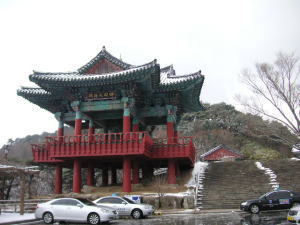
Entrance to the Seokguram Grotto |
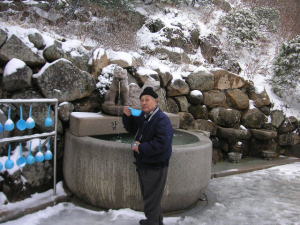 |
Water is so pure and sweet.
Mr. Noguchi, a famous travel essayist |
|
Bulguksa is a Buddhist
temple in the North Gyeongsang province in South Korea. It is home to
seven National treasures of South
Korea, including Dabotap and Seokgatap stone pagodas, Cheongun-gyo
(Blue Cloud Bridge), and two gilt-bronze statues of Buddha. The temple is
classified as Historic and Scenic Site No. 1 by the South Korean
government.[1] In 1995, Bulguksa
was added to the UNESCO World Heritage List together with the Seokguram Grotto, which lies four
kilometers to the east.
|
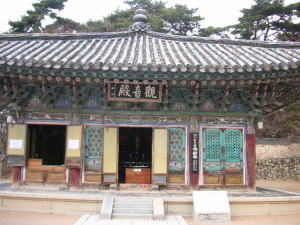 |
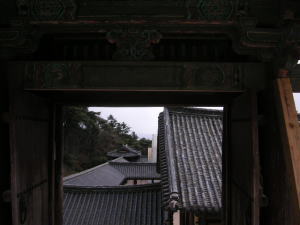 |
The temple is considered as a masterpiece of the golden age of Buddhist art
in the Silla kingdom. It is currently the
head temple of the 11th district of the Jogye Order of Korean Buddhism. |
| Various Silla-era stone carvings of Buddhas and bodhisattvas are found on
mountainsides throughout the city, particularly on Namsan. |
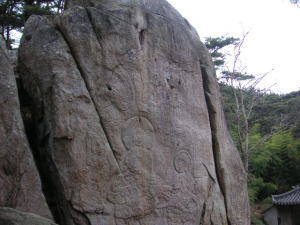 |
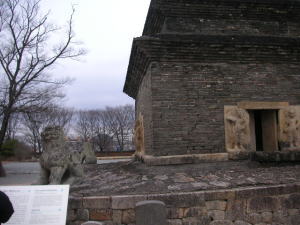 |
The ruins of Bunhwangsa Pagoda, the 30th national treasure of Korea, which is at
Bunhwangsa Temple. |
|
These three standing
Buddha Images are located at the foot of Mt. Namsan. They were brought here from
the Seonbang temple site in 1923. From the style, these Buddha images are
supposed to have been sculptured during the 7th century.
( Treasure No 63 )
|
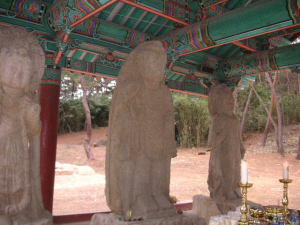 |
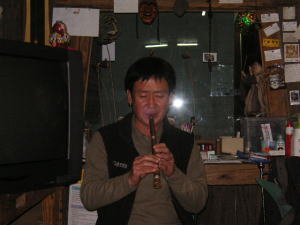 |
Sarangchae Guest House
Mr. Choo played bamboo flute for my husband to celebrate his birthday.
Thank you, Mr. Choo |
|
|

